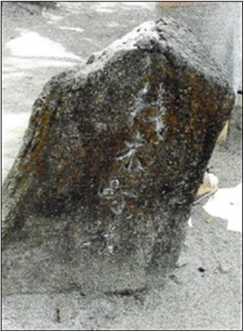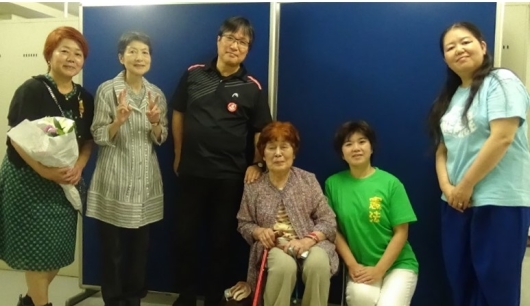My Atomic Bomb Experience(Ms.Matsumoto)
On May 4th, 2018, in Kure City, Hiroshima Prefecture, members of the Osaka singing group “Kansai Choir" listened to the atomic bomb experience of Mrs. Hideko Matsumoto (88). Mrs. Matsumoto was planning to speak about “That Moment" at the Closing General Meeting of the “World Congress on the Prohibition of Atomic and Hydrogen Bombs 2018 – Hiroshima". However, it was not possible due to the circumstances of the Congress. Because her story is a valuable testimony of an atomic bomb survivor, it was published as “My Atomic Bomb Experience" on August 24th on the blog of the Bulletin of the Japan Council Against Atomic and Hydrogen Bombs. (Yoshiko Baba)
My Atomic Bomb Experience
A stone monument in Zaimoku-cho where Mrs. Hideko Matsumoto’s family lived until just before the atomic bomb was dropped (around the center of the Hiroshima Peace Memorial Park) |
Hideko Matsumoto (88 years old)
The name of a city that disappeared is now a place of prayer
Until August 6th, 1945, when the first ever nuclear bomb was dropped, I lived in
Zaimoku-cho, Hiroshima City, with ten members of my family. It was in the middle
of what is now the Peace Memorial Park. Currently, even the name of Zaimoku-cho
no longer remains, but a stone monument engraved with “Ruins of Zaimoku-cho"
stands next to an explanatory panel in a piece of natural stone.
Recently, I sometimes have heard people say, “It’s a good thing the atomic bomb fell
on a park where no one lived." “That’s ridiculous." Although it is now a large and
quiet park, it used to be the busiest center in Hiroshima, with many large stores and
many people. Then the atomic bomb was dropped there, and the entire Nakajima
area became abandoned. In the process of reconstruction, this large place of prayer
was created. Even now, under the Peace Park, the remains of many people and the town where they lived are buried. A few years ago, a young woman was interviewed and said in a quiet tone: “I want you to walk this way gently."
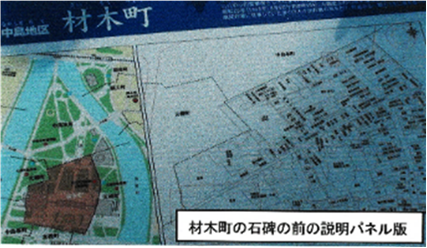 |
|
| Version of the explanatory panel in front of the stone monument of Zaimoku-cho |
Forced evacuation of buildings,
mobilization of all first and second
grade junior high school students
The Hiroshima Prefectural Government is located 1 km to
the south from the hypocenter, Hiroshima Castle rises in
the north, and during the Sino-Japanese War (1894-95), the
imperial headquarters was located there, making Hiroshima
a military capital. Around 1945, Hiroshima Prefecture was subjected to air raids by
the United States Armed Forces during the Asia-Pacific War (War in Greater East
Asia). In order to prevent the spread of fires from the air raids, forced evacuation of buildings was being promoted at a rapid pace. After that, all the junior high school boys and girls in the city along with people in the suburbs mobilized, and when they started to work…
Orange world, 5 or 6 seconds of silence, glass piercing my face, shoulders and arms
As usual, around 7:00 in the morning, I grabbed my mother’s lunchbox and said, “I’m leaving”, and took off for the girls’ school in Midori-machi, 3 km south of my house. Little did I know that it would be the final farewell to my family. I was talking with friends of mine on the second floor of the school building.
Then suddenly, really suddenly, without any warning, the world turned orange and I immediately crawled under my desk. Then there were about 5 or 6 seconds of silence. In the next moment, as I stood up, I was crushed by a tremendous blast and pressure of the explosion. I was hit with broken glass on the right side of my face, shoulders, and arms, and ran toward the bomb shelter in the schoolyard bleeding.
Burnt hair, hair a mess, torn skin, “Even Hell would not be like this…"
After that, there was no movement and no instructions from the school, and there was information that “the city area is in serious trouble”, so I decided to go home. Around noon, people who had escaped the smoke of the fire, and who had been burned by the tremendous flash of light, collapsed and sat on the Miyuki Bridge. So many people were evacuating, dragging their feet one after another as their hair stood on end and their skin was ripped and hanging down. I couldn’t give them anything, and I couldn’t even utter a word. It was such a tragic situation that it broke my heart to think “Even hell would not be like this." Up until just a few minutes ago, these people were pretty girls in sailor suits and dignified high school boys in gaiters. It appears that they were eventually taken away by military trucks and accommodated at Etajima and Tetsuwajima.
The earth crumbled under my feet, the crying was absorbed by the haunting silence
That day I couldn’t go home, and I was invited to stay at my aunt’s parents’ house near Zaimoku-cho in the midst of heavy congestion. That night, no one slept in the bright red night sky as Hiroshima burned, and I headed home early in the next morning on the 7th. There was still a lot of fire burning and I couldn’t get in, but on the 8th, that house… that Zaimoku-cho… the earth as far as I could see was crumbling under my feet, and I felt like I was standing alone in a unknown desert. Then my body shook and I cried. My voice was absorbed by the eerie silence around me.
My mother and my siblings…
I finally entered my house, which had changed. There were two clean white bones around the front entrance and the kitchen. “Oh, could it be my mother?"… “Or was it my sister?"… I collected them in a tea tin can. It rattled.
Around my house, there were four or five objects that had turned to charcoal… “Could this be my brother, Mamoru?"… “Is this my sister Toshiko?" I thought, but I couldn’t do anything about it.
A charred mother and child connected by an umbilical cord, a classmate who cremated his father and his younger brother
While walking around mindlessly, I came across a corpse whose eyes widened a few centimeters due to the pressure of the explosion. I instinctively joined hands with a charred mother, and a mother and baby who were still connected by the umbilical cord.
Namu Amida Butsu.
The 12- and 13-year-old junior high school students, who were mobilized to clean up after the building was evacuated in an attempt to create a firewall to prevent the spread of fire from air raids, waited for their parents as they desperately held the burned bodies, some of whom had already died.
Unfortunately, around Dohashi, the soldiers piled up many of the dead in one place and cremated them.
My classmate also cremated her father and her beloved younger brother with her own hands. She was talking about it in a later meeting. “At that time, they were 15-year-old girls."
3 days later, a reunion with my father, and a piece my sister’s clothes on the banks of the river
Early in the morning of the 9th, I was able to meet my father in Tetsuwajima thanks to the list of rescuers posted at key points in the town. My father was trapped under a building at an acquaintance’s house near Nakahiro-machi, but fortunately he had no major injuries, but his eyes were in pain.
The male and female students who were seriously injured or burned in Tetsuwajima were housed in a barracks and were receiving nursing care, but they died one after another, and were buried back in the mountains without hearing the voices of their parents and without ever seeing them.
Meanwhile, I had to hide from the air raid warning sirens. After spending two nights in Tetsuwajima, I was walking through the town to go to Ondo, when a piece of my sister Kiku’s clothing caught my eye on the banks of the Tenma River. She had remade my mother’s kimono and had made a matching one for me.
That morning, my 13-year-old sister said that she would go to Dohashi to clean up after the evacuation. I wonder if she went into the Tenma River as she took off her steaming clothes after the flash of light. On the 7th, I went by that side of the river, but I couldn’t find her. My pains my heart. I will never forget it.
40-year-old mother, 17-year-old sister, 13-year-old sister, 6-year-old brother, 4-year-old sister, 2-year-old brother, at the memorial tower
My 17-year-old sister was working at the Chugoku Shimbun headquarters in Nagarekawa at the time, but it is not known where she is now. I think my mother immediately held us children in her arms at that point, even though she was trapped under the house. Northwest of the memorial is a bun-shaped round earthen memorial tower for atomic bomb victims, which is about 10 meters in diameter. It contains the bones of approximately 70,000 people regardless of their nationalities or religions, and statues of Jibo Kannon, the Goddess of Mercy.
My family, including my 40-year-old mother, 17-year-old sister, 13-year-old sister, my energetic 6-year-old brother Tsutomu who was just in the first grade at the time, my 4-year-old sister Toshiko, and my 2-year-old brother Mamoru are also enshrined in this memorial tower. It is an important tomb for me. Whenever I come to Zaimoku-cho, I always visit it.
My father and I went to Ondo, and my brothers and sisters who were evacuated, also lived in Ondo thanks to the kindness of their relatives.
Falling hair, melted teeth and chin, bloated body, my father died at the age of 58
My father was deprived of his wife, his six children and all the basics of life at once. In addition, he was badly injured by the horrific atomic bombing. His hair fell out, his whole body swelled up, the flesh of his mouth melted, and his teeth and even the bones of his upper jaw melted away. Seeing that, we all shuddered at the horror of the radiation. My 42-year-old middle-aged father had transformed into a 100-year-old grandfather in one fell swoop. My father was injured by the atomic bomb, developed cancer, and died at the young age of 58.
I still get nervous when I see numbers 8 and 6
What was the purpose of this war? What could that terrifying atomic bomb do? What should I tell the victims, my father and my sisters? I’ll meet them all soon…
I didn’t like going to Hiroshima. I couldn’t go for a while. I felt as if my home was being trampled upon. I still get nervous when I see the numbers 8 and 6 in a row. But now that I’m getting older and love to sing, I’m enjoying the chorus with my friends under the guidance of a wonderful teacher. This is also only in a peaceful world.
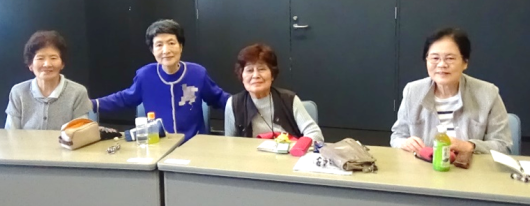 |
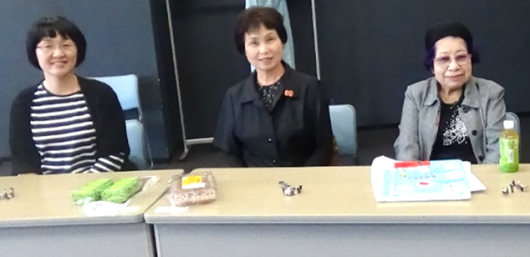 |
| May 23th, 2018, Otodo Family Chorus members. From the left, Mrs. Ishijima, Baba, Mrs. Matsumoto, Mrs. Takada, Mrs. Takeda, and Mrs. Kunisada, my sister | |
“A world without war, without nuclear weapons", we connect this wish
A large number of people from all over the world gather in Hiroshima, hoping for a world without war and without nuclear weapons. I think it would be great if this wish could be connected to that person and this person with a high five. Let’s connect.
“When Pikadon falls, day becomes night and people become ghosts."
This is the poetic verse of a child that was published in the Chugoku Shimbun shortly after the bombing. In the Eastern Memorial Hall of the Atomic Bomb Museum, there is an exhibition of pictures drawn by A-bomb survivors of the immediate aftermath of the atomic bombing. The pictures are replaced and displayed in different series. Please take a look.
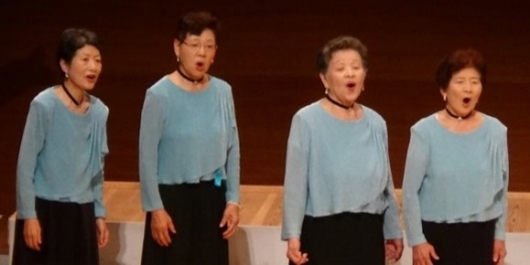 |
 |
||
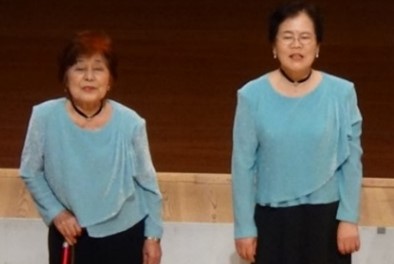 |
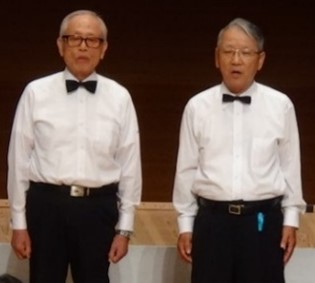 |
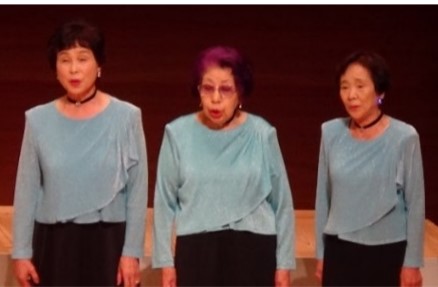 |
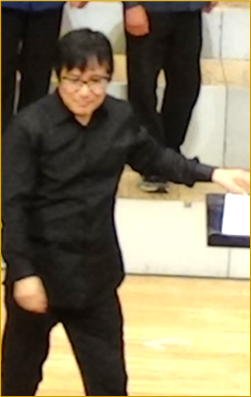 |
| Members of the Ondo Family Chorus at the 2017 Hiroshima Song Festival (above). From the left to the right, Mrs. Kunisada, my sister, Mrs. Matsumoto, and Mrs. Keiko Takada who participated in the Kure Tanpopo Chorus (bottom). | |||
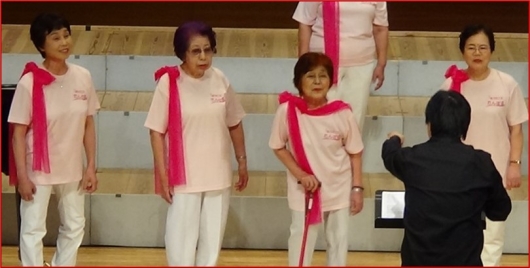 |
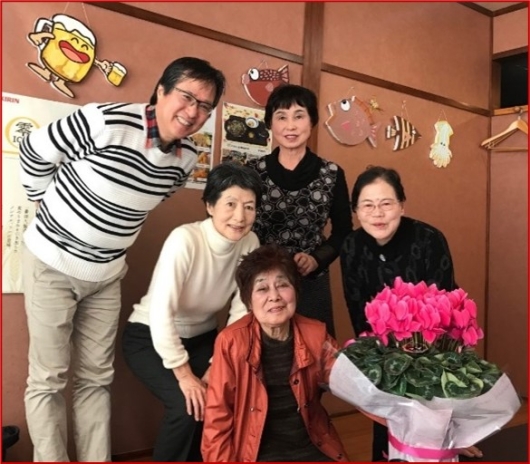 |
| On December 6th, 2017, a commemorative photo of Mrs. Hideko Matsumoto’s 88-year-old celebration, with members of the Ondo Family Chorus (the conductor on the upper right is Professor Ryuji Takada). |
| After the Closing General Meeting of the 8.6 World Congress on the Prohibition of Atomic and Hydrogen Bombs 2018, in the waiting room. From the left, Mrs. Hideko Matsumoto’s daughter, Baba, Professor Takada, Mrs. Hideko Matsumoto, Mrs. Tomoko Sumihiro and Mrs. Yoko Kodama.
|
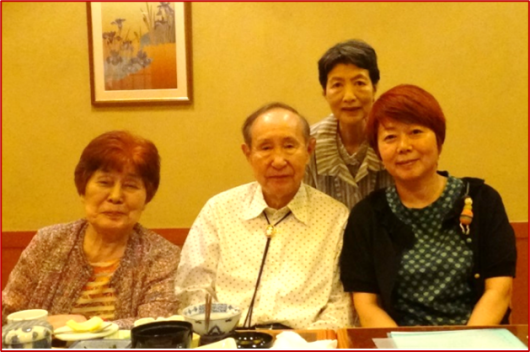 |
| Lunch for 8.6 former Nakajima National School alumni. From the left, Mrs. Hideko Matsumoto, Mr. Eiichi Uneda, Baba, and Mrs. Matsumoto’s daughter. |
